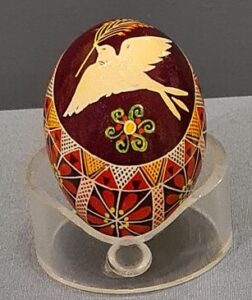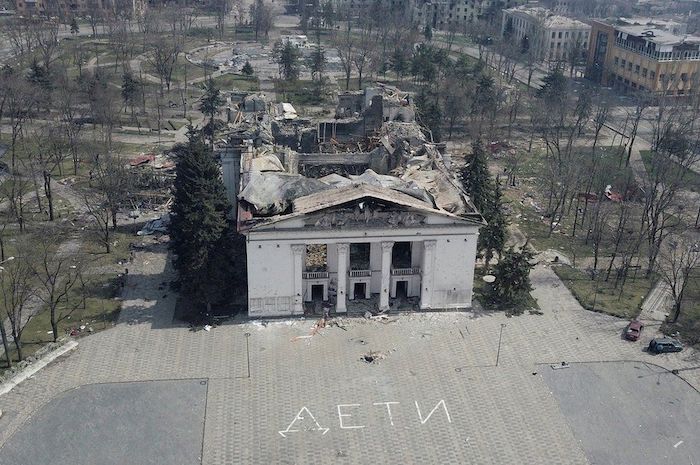UKRAINE – World News Bites
Russians Removing Ancient Monuments from Mariupol

Cuman/Polovtsian statues from from the Kharkiv Oblast, Ukraine, in the Nues Museum in Berlin, Germany. Photo by Ethan Doyle White, CCA-SA 3.0 Unported license.
Ukraine’s Center for National Resistance reported that Russian forces in Mariupol, Donetsk region, are illegally exporting Ukrainian museum artifacts from the occupied territories. Recently excavated 11th-12th century stone statues from the Polovtsian culture were handed over to the Mariupol Museum of Local Lore by Russian guard forces. Since falling under Russian control, the museum has been used to “legalize” stolen Ukrainian artifacts and then transfer them to Russian museums.
The Mariupol Museum of Local Lore was one of the first victims of Russian shelling during the full-scale invasion, resulting in its destruction by fire. However, much of the cultural loss was due to looting by Russian forces, who took artworks and artifacts to occupied Donetsk, including paintings by renowned artist Arkhip Kuindzhi. The museum’s former director, Natalia Kapusnikova, put in place by Russian forces, later fled to Russia. She is blamed for facilitating the thefts.
In addition, in March, Russian troops destroyed the ancient Did mound in Mariupol, a historical site dating back to the 5th millennium BCE.
Stolen Artwork Spotted In Crimea Press Event
The Kherson Art Museum in Ukraine continues to identify artworks stolen by Russian occupiers, so far museum staff have confirmed that 121 pieces have been stolen. The most recent identified piece is a landscape by

Painting by Ukrainian artist Heorhiy Cherniavskyi, “Dalni Zelentsi Bay,” taken by Russian forces from the Kherson Museum.
On April 1, 2023, a photo was taken at the Central Museum of Tavrida during a staged signing of an agreement for storing (stolen) items from Kherson in Crimea. This image features a pastel work by Ukrainian artist Heorhiy Cherniavskyi titled “Dalni Zelentsi Bay. Staff at the Kherson museum was able to see the painting’s original inventory number in one of the frames of the video.
Heorhiy Cherniavskyi (1924-1981) was a People’s Artist of Ukraine and a significant figure in the Dnipro school of painting, recognized among the top 100 Ukrainian artists.
Other paintings identified as stolen are “Old Crimea” by Emilia Honcharova, “Kosari” by Maria Schneider-Seniuk. The Crimean administration overseeing cultural artifacts has ordered preparations for the “evacuation” of valuable art pieces from the occupied territories.
Ukraine’s Overwhelming Human and Cultural Losses
The Ministry of Culture and Strategic Communications of Ukraine states that as of September 2024, that 123 artists and cultural figures have been killed.1,147 heritage sites have been destroyed or damaged.
2,044 cultural infrastructure sites have been destroyed or damaged.
2,123 cultural institutions have suspended their activities in the occupied territories.
500,000 museum artifacts have been evacuated.
1,700,000 museum items remain in the occupied territories.
State Department Backing for Ukraine Initiatives

Announcement at International Centre for the Study of the Preservation and Restoration of Cultural Property (ICCROM) to safeguard Ukraine’s cultural heritage.
U.S. State Department Acting Under Secretary Lee Satterfield announced a $1 million contribution to the International Centre for the Study of the Preservation and Restoration of Cultural Property (ICCROM) at the G7 Culture Ministerial in Naples to help Ukraine protect its cultural heritage.
Then, on September 26, in conjunction with the UN General Assembly, Satterfield unveiled two additional U.S.-funded projects as part of the Ukraine Cultural Heritage Response Initiative. The first is a collaboration with the University of Pennsylvania’s Cultural Heritage Center, to enhance skills to repair cultural sites and combat false narratives about Russia’s war. The second project involves the U.S. Department of Justice and FBI working with Ukraine’s Prosecutor General to assist Ukraine’s investigation and prosecution of heritage crimes.
U.S. Restricts Import of Virtually All Objects Made in Last 1.4 Million Years

Miniature Ceramic Dishes – National Museum of Ukrainian Pottery – Opishnya – Ukraine,
Photo by Adam Jones from Kelowna, BC, Canada, CCA-SA 2.0 Generic license.
Emergency import restrictions were imposed on Ukrainian ‘cultural objects’ in the Federal Register on September 10, 2024. The import restrictions cover a comprehensive range of Ukrainian cultural property. They will last, at a minimum, until March 5, 2029.
The 10-page long list of prohibited objects (over 7500 words in the Federal Register), appears to include every item made by human hands in the last 1.4 million years.
Ethnological material in the Designated List includes: ethnological religious and ritual objects, and objects related to funerary rites and burials dating from 200 C.E. to 1917 C.E.; ethnological manuscripts, written documents, and early prints dating from 900 C.E. to 1917 C.E.; ethnological architectural elements dating from 200 C.E. to 1917 C.E.; and ethnological paintings, military material, and traditional folk clothing and textiles dating from 1700 C.E. to 1917 C.E.

Easter egg (pysanky), a dove of peace, Ukraine, 1970-1980, British Museum (exhibition Ukraine: Culture in crisis), 12 January 2023, photo Ji-Elle, CCA-SA 4.0 International license.
An abbreviated version of the Designated List states that it covers archaeological material in stone, ceramic, glass, wood and other materials ranging in date from the Paleolithic period (c. 1.4 million years ago) through 1774 C.E. Ethnographic art restrictions prohibit entry to virtually everything made in Ukraine up to 1917.
Under the law that governs import restrictions, the Cultural Property Implementation Act, Designated Lists of restricted imports are supposed to include only significant objects important to the heritage of a country. All items are supposed to be subject to current looting for a U.S. market. In addition, the lists are expected to provide clear guidance to importers about what is and is not covered. However, the Federal Register announcement states that, “The designated list set forth is representative only. Any dates and dimensions are approximate,” which expands the covered items even further.
The Designated List includes Jewish and Christian religious objects, including Jewish seder plates, and Hanukkah menorah. Lembyk drinking vessels, wall-mounted lighting fixtures that reflect candlelight in synagogues (reflectors), Hanukkah lamps, thuribles (kadylo), ritual boxes for storing Sabbath spices (bsamim), Torah crowns, Torah shields (tas), small boxes for storing Torah scrolls (mezuzah), Torah pointers, chalices (potyr), Eucharistic plates (diskoi), metal arches to cover diskoi (stars), double-edged knives with short triangular blades (spears), clergymen’s headwear (miters), cross-reliquaries (encolpion), pectoral crosses, clergymen’s round-form insignia (panagia), and pastoral staffs (crosiers), decorative curtains such as those for the royal doors of iconostases (Katapetasmas), or those for covering a Torah ark (parokhet), and decorative elements for synagogue curtains (lambrequin kaporets).
U.S. CPB Seizes Four Medieval Sabers Labeled ‘Barbecue Kit’

WASHINGTON (September 21, 2023) Homeland Security Secretary Alejandro Mayorkas delivers remarks at the Ukraine Cultural Artifacts Repatriation Ceremony with Ukrainian President, Volodymyr Zelensky, at the Embassy of Ukraine in Washington, DC. (DHS photo by Tia Dufour)
However, despite the listing of objects spanning 1.4 million years in the Designated List under the Cultural Property Implementation Act, the does not appear to be a trade in looted objects that would justify such extreme restrictions. All the illegally removed objects from Ukraine that have come into the United States have been sent from Russia. So far, officials have identified only eleven items as possibly from Ukraine among Russian shipments to the U.S. These include four recently returned medieval sabers stolen by Russia from Ukraine. The sabers, dating back to the 9th-13th centuries, were seized by U.S. Customs in Newark in a package falsely labeled as a barbecue kit. Any such stolen objects are already prohibited from entry and would be returned to Ukraine even without the current import restrictions.
A handover ceremony for the sabers took place at the Embassy of Ukraine to the UN, involving the Minister of Culture and Strategic Communications of Ukraine and Robert Silvers, Under Secretary of Homeland Security for Strategy, Policy, and Planning. Meanwhile Ukraine’s cultural ministry is creating a database of objects from Ukrainian museums as a resource to track down missing objects.
 Donetsk Academic Regional Drama Theater in Mariupol, bombed by the Russians March 16, 2022, when about 1000 civilians were sheltering inside. At least 600 were killed. The word "children" is written on the plaza in front.
Donetsk Academic Regional Drama Theater in Mariupol, bombed by the Russians March 16, 2022, when about 1000 civilians were sheltering inside. At least 600 were killed. The word "children" is written on the plaza in front. 

